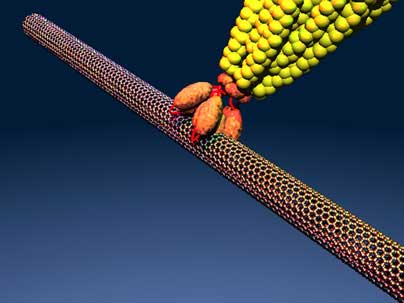Powerful Ideas: Electronics Grown by Germs

Editor's Note: This occasional series looks at powerful ideas — some existing, some futuristic — for fueling and electrifying modern life.
Ancient germs that hunt bacteria are now getting recruited to assemble the electronics of the future. Scientists are using viruses to build solar cells and other gadgets that are dramatic improvements over their existing counterparts. These new techniques also manufacture the devices in a way that is far safer for the environment than current methods.
"We live in a time now when so many problems need to be solved, very important problems. We think we have an advantage because we're using biology, with evolution helping us get better," explained researcher Angela Belcher, a materials scientist at MIT.
The germs in question are called bacteriophages, or "bacteria eaters." The rod-shaped viruses that Belcher and her colleagues employ are typically just nanometers or billionths of a meter wide, thinner than a wavelength of visible light.
Bacteriophages are like a plague upon bacteria, grabbing onto their victims using coats adorned with special proteins. The researchers genetically modify these phages so these proteins latch onto metal,, eventually forming structures such as wires. The technique also allows for the pinpointing of which specific proteins grow where on the viruses, and to which metals they bind.
So far Belcher and her colleagues have used these viruses to build a high-power, coin-sized battery that rivals the state-of-the-art rechargeable ones found in personal electronics and hybrid vehicles. The team made it using amorphous iron phosphate, which is cheaper and environmentally friendlier than the materials used in lithium ion batteries, and which normally is a poor conductor, except when constructed at the nanometer scale as the viruses did.
"I think we can get power performance up to twice as what you see in conventional batteries today," Belcher said.
Get the world’s most fascinating discoveries delivered straight to your inbox.
In addition, the scientists are attempting to biologically grow solar cells, "trying to drop them in price," and assemble better fuel cells, she added. "I'm really excited about energy in general."
The researchers often optimize their viruses by creating many versions, each with a different mutant of a gene, and seeing which ones work best. In this way, they let evolutionary processes sort out the best answer.
In addition to making gadgets that are better than existing counterparts, the phages also manufacture devices in a more energy efficient and environmentally friendly way, foregoing the toxic solvents and the high temperatures often used in factories for water and temperatures below boiling. "We can't grow them in conditions that will kill the bacteriophages," Belcher said.
Belcher first began her research by investigating how abalone grows shell from calcium carbonate, "and then I developed the idea of selecting and evolving creatures to work with the rest of the periodic table."
Initially, Belcher investigated growing microchips with phages, "but then we started thinking about how to get real products that you could hold in your hand in the short term, which is when we started thinking along the lines of batteries," she explained. "But I'm definitely still interested in making microchips."
Other Powerful Ideas:



